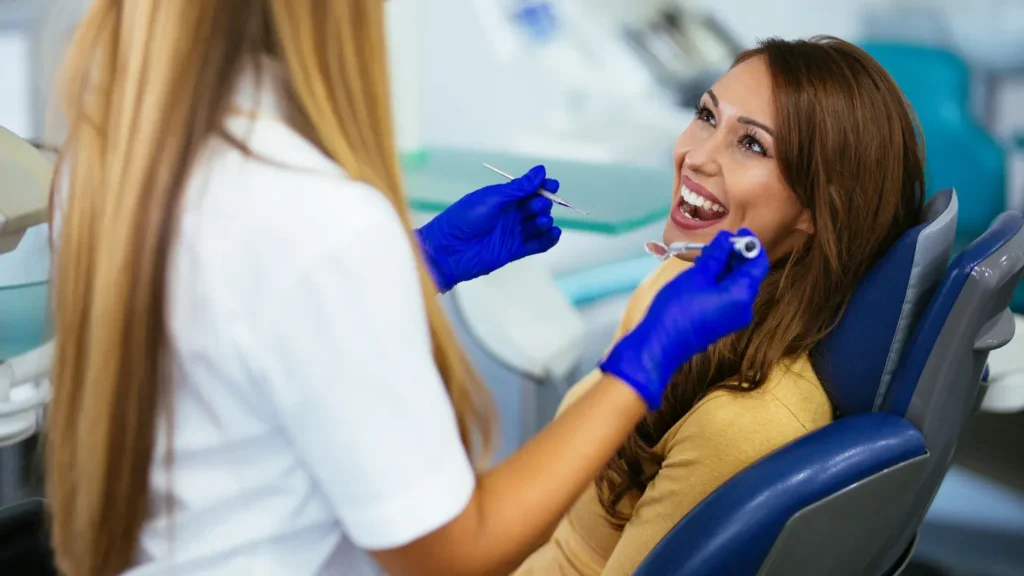Tooth Pain After Flossing? Why Do My Teeth Pain After Flossing?

Table of Contents
Ever wondered why your teeth hurt after flossing? Flossing is a vital part of oral hygiene that many people often skip due to the discomfort it can cause. However, this essential step in your daily routine plays a crucial role in maintaining your oral health. The pain you experience can be discouraging, but understanding its causes can help you address and prevent it.
Curious about what might be causing your tooth pain after flossing? Keep reading to explore the common reasons behind this issue and discover effective ways to prevent it, ensuring a comfortable and healthy flossing routine.
What is flossing?
Flossing is a dental hygiene practice that involves using a thin piece of string-like material, known as dental floss, to clean between the teeth and along the gumline. It’s an essential part of oral hygiene along with brushing, as it helps remove plaque, food particles, and bacteria from areas that a toothbrush cannot reach effectively.
Flossing helps prevent tooth decay, gum disease, and bad breath by removing debris and bacteria from between the teeth and beneath the gumline, where toothbrush bristles cannot access. It’s typically recommended to floss at least once a day, preferably before brushing, to maintain optimal oral health.
Experiencing tooth pain after flossing can be an alarming and uncomfortable experience, often leaving you puzzled and concerned about the underlying cause. However, gaining insight into the reasons behind this discomfort is pivotal for effectively addressing the issue and finding relief.
In this blog post, we aim to tell you the intricacies of tooth pain following flossing, exploring ten prevalent factors that may cause Tooth Pain After Flossing.
By understanding how these factors can impact oral health and contribute to post-flossing pain, you will know the necessary things to identify the specific cause of their discomfort.
Moreover, we won’t just stop at identification – our goal is to provide actionable strategies and tips to help manage and alleviate tooth pain after flossing. Whether it’s adjusting flossing
techniques, seeking professional dental care, or incorporating preventive measures into one’s oral hygiene routine, we aim to offer practical solutions tailored to individual needs.
10 Common Causes of Teeth Pain After Flossing
1. Improper Technique:
Improper flossing technique is a common culprit behind tooth pain after flossing. When individuals floss too aggressively or incorrectly, they risk damaging their gums or irritating sensitive areas, leading to discomfort.
For instance, vigorous back-and-forth motions or snapping the floss against the gums can cause abrasions or even cuts. Instead, a gentle, up-and-down motion should be employed to effectively remove plaque and debris without harming the gums.
2. Gum Disease:
Gum disease, including gingivitis and periodontitis, is a prevalent cause of pain during flossing. These conditions result from bacterial plaque accumulation along the gum line, leading to inflammation, bleeding, and discomfort.
Individuals with gum disease may experience heightened sensitivity during flossing due to the inflamed and tender nature of the gums. To manage gum disease, thorough oral hygiene practices, such as regular brushing and flossing, are crucial, along with professional dental cleanings to remove plaque and tartar buildup.
3. Tooth Decay:
Tooth decay or cavities near the gum line can elicit sharp pain or sensitivity when flossing. The friction of the floss against the decayed area exacerbates discomfort, making routine oral hygiene practices challenging. Prompt intervention, such as dental fillings or crowns, is essential to address decay and prevent further pain and damage.
For example, if a cavity is left untreated, it can progress deeper into the tooth, potentially leading to more severe complications such as tooth infection or abscess.
4. Gum Recession:
Gum recession exposes the sensitive roots of the teeth, increasing susceptibility to pain and discomfort during flossing. Individuals may notice their gums pulling away from the teeth, revealing more of the tooth structure. This exposes the softer, more sensitive root surface to stimuli such as flossing, resulting in heightened discomfort.
Gum recession can be caused by factors such as aggressive brushing, gum disease, or genetics. To address gum recession, individuals should seek professional dental evaluation and may require treatments such as gum grafting to restore gum tissue and alleviate pain.
5. Dental Restorations:
Dental restorations like fillings, crowns, or bridges can sometimes cause pain or sensitivity during flossing, especially if they’re not properly fitted or if there’s a gap between the restoration and the natural tooth.
For example, a poorly fitting crown may create a space where food particles can become trapped, leading to irritation and discomfort during flossing. Individuals with dental restorations experiencing pain should consult their dentist for evaluation and potential adjustments to alleviate discomfort.
6. Tooth Sensitivity:
Tooth sensitivity can cause pain or discomfort when flossing, particularly if abrasive floss or aggressive flossing techniques are used. Tooth sensitivity can be caused by factors such as enamel erosion, gum recession, or exposed tooth roots.
For individuals with sensitive teeth, using soft or sensitive floss and adopting gentle flossing techniques can help minimize discomfort while effectively removing plaque and debris.
7. Food Impaction:
Food particles trapped between teeth can cause irritation and pain during flossing. While proper flossing techniques can dislodge these particles, persistent pain may indicate underlying issues such as decay or gum disease.
For example, if a cavity develops between two teeth, it can trap food particles and bacteria, leading to irritation and discomfort during flossing. Individuals experiencing persistent pain should seek dental evaluation to identify and address the underlying cause.
8. Tooth Fracture:
A fractured tooth can cause sharp pain or discomfort, especially when pressure is applied during flossing. Tooth fractures can result from various factors such as trauma, grinding or clenching, or biting down on hard objects.
If a tooth fracture is suspected, individuals should seek prompt dental evaluation to prevent further damage and alleviate associated pain. Depending on the severity of the fracture, treatment options may include dental bonding, a dental crown, or root canal therapy.
9. Oral Infections:
Infections affecting the gums or tooth pulp can induce pain and sensitivity, particularly during flossing. These infections can result from untreated cavities, gum disease, or dental trauma. Oral infections require prompt dental attention to prevent further complications such as abscess formation or tooth loss.
Treatment may include antibiotics, root canal therapy, or surgical intervention, depending on the severity of the infection.
10. Orthodontic Treatment:
Orthodontic appliances like braces or aligners can make flossing more challenging and sometimes cause discomfort or pain.
For example, wires or brackets may poke or irritate the gums, leading to discomfort during flossing. Individuals undergoing orthodontic treatment should follow their orthodontist’s instructions for proper flossing techniques and may benefit from specialized tools such as floss threaders or interdental brushes to effectively clean around braces or wires.
Regular dental check-ups are essential to monitor oral health during orthodontic treatment and address any discomfort or issues promptly.
Prevention Measures to Avoid Tooth Pain After Flossing:
To prevent tooth pain after flossing, consider implementing the following measures:
1. Proper Technique:
Ensure you’re using the correct flossing technique. Use gentle, up-and-down motions to avoid damaging the gums or irritating sensitive areas. Avoid snapping the floss against the gums or using excessive force.
2. Regular Flossing:
Consistency is key. Floss at least once a day to remove plaque and debris between teeth, reducing the risk of inflammation and discomfort.
3. Use Soft Floss:
Opt for soft or waxed dental floss to minimize irritation and discomfort. Avoid abrasive floss that may exacerbate tooth sensitivity or cause gum irritation.
4. Regular Dental Check-ups:
Schedule regular dental check-ups to monitor your oral health and address any issues promptly. Your dentist can detect and treat problems such as tooth decay, gum disease, or dental restorations that may contribute to post-flossing pain.
5. Professional Guidance:
Seek guidance from your dentist or dental hygienist on proper flossing techniques tailored to your specific oral health needs. They can provide personalized advice and recommend suitable oral hygiene products to help prevent tooth pain after flossing. Dr. Shariff – A professional Dentist in Orange at Smile N Shine Dental Care can help you with professional guidance.
6. Try Alternative Cleaning Tools like Electric Floss (Waterpik)
If traditional flossing causes you discomfort or is simply too challenging, especially when trying to reach the back teeth, it might be time to consider alternative cleaning tools. One such alternative is the electric floss, commonly known as a Waterpik or water flosser. This device uses a stream of pulsating water to remove food particles and plaque from between your teeth and along the gumline.
Benefits of Using an Electric Floss (Waterpik)
Ease of Use
For Hard-to-Reach Areas: The design of a Waterpik makes it significantly easier to clean those difficult-to-reach areas at the back of your mouth. The water jet can navigate around molars and other tight spots that traditional floss might miss.
Ideal for Braces: If you have braces or other orthodontic appliances, a Waterpik can be particularly beneficial. The water stream can clean around brackets and wires, where traditional floss might struggle.
Gentle on Gums
Reduced Risk of Injury: Traditional flossing can sometimes cause gum irritation or bleeding if not done correctly. A Waterpik is gentler, as the pulsating water massages the gums, reducing the risk of injury.
Promotes Gum Health: The massaging action can also stimulate gum health, potentially reducing inflammation and bleeding over time.
By incorporating an electric floss (Waterpik) into your oral care routine, you can enhance your dental hygiene, making it easier and more comfortable to maintain healthy teeth and gums. This can be particularly beneficial if you experience pain with traditional flossing or have special dental needs, such as braces.
Conclusion:
Tooth pain after flossing can have various causes, from minor issues like improper technique to more serious concerns like gum disease or tooth decay.
If you experience persistent or severe pain when flossing, consult with your dentist for proper diagnosis and treatment.
Remember to floss gently, use the right tools and techniques, and maintain regular dental check-ups to keep your smile healthy and pain-free.
GET IN TOUCH
Ready to achieve a pain-free smile and optimal oral health?
Schedule a consultation with Smile N Shine Dental Care today! Our experienced team is here to provide personalized advice, preventive care, and treatment solutions tailored to your unique needs. Don’t let tooth pain after flossing hold you back – take the first step towards a healthier smile with us.






